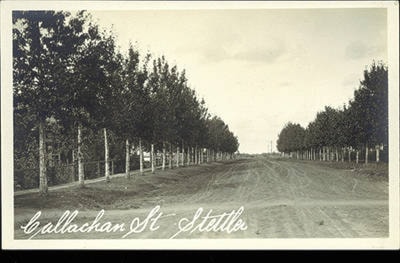By Carson Ellis
For the Independent
When the Canadian Pacific first came to the little terminus that would be called Stettler, there wasn’t much around.
The prairie community was essentially that. Prairie.
When you look at old pictures of early settlers in the district, it’s not hard to see a lot of nothing surrounding them. The railroads had a common practice of building large, beautiful gardens at their stations.
Station agents had portions of their budget allocated to huge display gardens, often times with plant life found in the area.
The idea was to attract settlers moving to the region to stay at one of the stations and help settle the area. The attractive gardens, however, were limited to the train station.
Early community leaders recognized the need to make their communities stand out from other townsites along the rail line, and even from different sites that sprang up independent of the railway.
One problem Carl Stettler was noted as having in his feverish campaign to bring fellow Swiss immigrants to his new community, was scenery.
It was hard to convince them to move from their lush treescapes and mountain homes, to the flat boring prairie the new townsite was to be created in.
So in 1907 the community of Stettler was trying to figure out how to make their community more appealing to those that lived here and those that may one day live there.
The campaign to improve the community’s appearance would be spearheaded by the town’s first mayor.
Mr. N.B. McGillivray began the campaign to plant trees in the community. He got the town council on board, and quickly offered a 15 per cent reduction in taxes to anyone who was willing to plant and maintain trees on their property.
This effort to improve the aesthetic appeal of the community was aided by many early settlers.
Many of them were new to both the district and the county. The change from countries thick with trees to miles of prairies, and nothing else was not an enjoyable one.
They happily took part in the campaign to improve their surroundings. The campaign would be so successful, the town would continue the tax rebate until 1915.
Understanding they were just as responsible to improve the look of the community as the residents, the town was quick to start planting trees in public spaces.
Poplars, palm of gileads, willows and spruce trees were just some of the popular specimens planted by the town and its individual citizens.
By 1929, the town had become fairly well-known for its tree-lined streets and homes. Front yards and backyards were known to be well-shaded.
Town streets were bordered with tree growth. Citizens would often reap an additional benefit from their efforts in the summertime.
With the trees that surrounded their homes and walkways, citizens were able to find shelter from the summer sun that would beat down upon them.
Finding some comfort in smaller trees was considered a better option than being completely exposed to the glaring heat.
One story that was recently shared with me from a citizen who grew up in Stettler was that the trees along one street were so thick at one point, him and his friends could climb into their branches and were practically invisible to anyone on the ground.
I myself remember years back when the street along the fair grounds was lined with tall, sprawling trees.
I was rather upset when they were cut down. It made a bit more sense when I was told that it had been an unfortunate necessity since the roots had grown into water lines, and whatever else they had started enveloping.
It is nice to see they’re growing again, but it will be a few years before it is quite the same. At least to me anyway.
